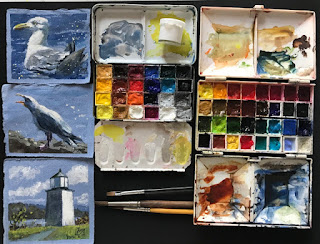Usually, before you start thinking about making gouache or
even trying this type of paint, you will learn that gouache and watercolor are
two closely related mediums that are famous for how easy it is to get involved
with it. For the same reason, it is not uncommon for them to be the gateway to
many other media even at an early age, since they provide a large number of
possibilities while their handling remains quite simple and enjoyable with the
beginning artist.
Of course, when you begins to go more towards the detail and
precision in the representation, you can discover that it is a medium that
contains a large number of techniques with which one can work in great depth.
Do you know what are the main characteristics of gouache and
the difference it holds with watercolors? In this publication, American artist Ari
Glass will identify them and what is more, he will explain how to make your own
artisanal (or homemade) gouache, which will allow you to work at oyur ease with
this fabulous medium.
Gouache
While the term “gouache” wasn’t introduced until the 18th
century, similarly opaque water-based mediums have been used by artists for
thousands of years. This form of gouache was widely used in manuscript production,
and the colors used were those present in the medieval and renaissance color
palette:
·
Red: Cinnabar, Vermilion, Brazilwood, Alizarin,
Dragon's Blood (no dragons were injured in the process; it was obtained from a
plant), Lake Caramine
·
Blue: azurite, crozophora, ultramarine, enamel
·
Green: malachite, verdigris, terre verde
·
White: lead (toxic), lime white
·
Yellow: ocher, saffron, orpiment, Naples yellow
·
Brown / Black: Charcoal, Ivory / Bone, Lamp,
Amber
Some of these are no longer in circulation due to their
toxicity, but they were key in the pictorial arts for a long time.
Certainly, it is likely that the tempera-style version of
gouache is the oldest of all (and ultimately, it is also one of the forms of
preparation that we will see to make gouache), but today we can find a
considerable number of variations due to the diversification of materials with
which it is possible to work , that have been discovered over time.
Today, contemporary artists like Ari Glass value gouache
because it provides precision, full, flat color coverage, and crisp edges. It
can be used to paint lettering or fill in drawings, it allows flexibility
because mistakes can be covered up.
